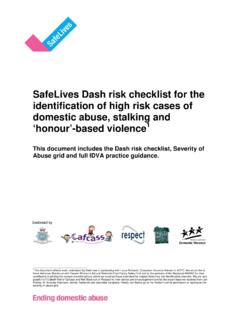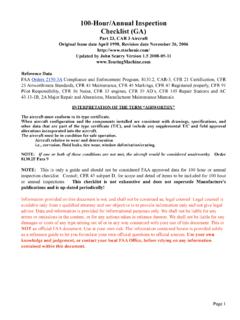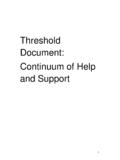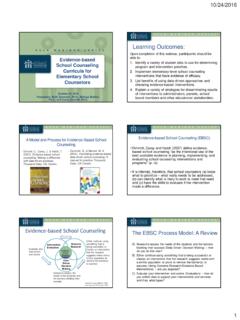Transcription of Girlhood Studies Style Guide - Anthropology in Action
1 Girlhood Studies Information for Contributors and Style Guide Table of Contents I. Submission Information, 1 2 vii. Ethnicity, 5. a. Formatting d. Possessives, 5. b. Cover page i. Exceptions, 5. c. Abstract/keywords e. Dates, 6. d. Copyright/permissions f. Currency, 6. e. Artwork g. Time, 6. f. Process for refereeing articles h. Numbers & Measurements, 6 7. g. Publication i. Series, 7. i. Abbreviations & Contractions, 7. II. Style Guide , 2 9 i. Foreign languages, 7. a. Punctuation, 2 3 ii. Diacritical marks, 7. i. Periods, 2 j. Translations, 8. ii. Commas, 2 k. Italics/Bold, 8. iii. Colons, 2 l. Quotations, 8 9. iv. Questions marks, 2 i. Double quotation marks, 8. v. Exclamation points, 3 ii. Single quotation marks, 9. vi. Parentheses & brackets, 3 iii. Brackets & capitalization, 9. vii. Dashes, 3 m. Bias/Parochialisms, 9. viii. Ellipses points, 3. b. Hyphenation, 4 III. Citation System, 10 12. c.
2 Capitalization, 4 5 a. Notes, 10. i. Publication titles, 4 b. Reference lists, 10. ii. Geographical, 4 c. States, 10. iii. Institutions, 4 d. Examples, 11 12. iv. Periods/eras, 4. v. Political, 5 IV. Article Submission Checklist, 13. vi. Titles, 5. Style Guide Girlhood Studies SUBMISSION INFORMATION FOR CONTRIBUTORS. Please send submissions of articles, reviews, and other contributions as email attachments (MS Word is preferred, otherwise in rich text format) to the editors at Articles should have a maximum of 6,500 words (including abstract, notes, and references, as well as biographical information and acknowledgments). Book reviews should be approximately 1,500 words. Please consult with the editors concerning appropriate lengths for reviews and review articles. FORMATTING. The document must be set at the US letter standard size. The entire document (including notes and references). should be double-spaced with 1-inch ( cm) margins on all sides.
3 A 12-point standard font such as Times or Times New Roman is required and should be used for all text, including headings, notes, and references. Any unusual characters or diacritical marks should be flagged by placing the entire word in red type. COVER PAGE. The cover page should provide the title of the article, complete contact information for each author (mailing address, phone number, and email), biographical data of approximately 100 words for each author (including an ORCID if applicable), a total word count, the number of tables and/or figures included, and any acknowledgments. Affiliations and email addresses will be posted online for indexing/abstracting purposes. ABSTRACT/KEYWORDS. The article must include an abstract of 125 words and 5 to 8 keywords. The abstract should not duplicate the text verbatim but rather include the research question or puzzle, identify the data, and give some indication of the findings.
4 Keywords should be drawn from the content and not duplicate the article title, listed in alphabetical order, and separated by commas; only proper nouns should be capitalized. COPYRIGHT/PERMISSIONS. Upon acceptance, authors are required to submit copyright agreements and all necessary permission letters for reprinting or modifying copyrighted materials, both textual and graphic. The author is fully responsible for obtaining all permissions and clearing any associated fees to reproduce copyrighted materials. ARTWORK. For optimal reproduction, figures or photos should be submitted as high-resolution JPGs or TIFFs (300 ppi), or as EPS. files with all fonts embedded. All images should be at least 4 x 4 inches at the resolution indicated. Tables should be made and submitted in Microsoft Word or rtf. All figures and tables should be in separate files and numbered consecutively; only placement indicators and captions (with source/copyright information) should be included in the articles themselves.
5 For more details, please see our Artwork submission webpage. PROCESS FOR REFEREEING AND ACCEPTING ARTICLES. Girlhood Studies is a refereed journal. Submissions are considered on the understanding that the paper is not currently under consideration for publication elsewhere. Articles are sent to at least two scholars with relevant experience and expertise. Referees are asked to advise the editors whether the article should be published and if so, with what recommended changes. The editors respond to the author with their decision and a list of any changes needed for the article to be accepted for publication. They also send the anonymous referees' comments to the author, or a summary thereof. 2. Style Guide PUBLICATION. Manuscripts accepted for publication that do not conform to the Style Guide may be rejected or returned to the author for amendment. The editors also reserve the right to alter usage to conform to the Style Guide issued by the publisher.
6 Authors cannot supply new materials or request major alterations following the copyediting stage, so please ensure that all text is final upon acceptance. Contributors of research articles will receive one free copy of the relevant issue and may purchase additional copies at a reduced price or purchase offprints. Have other questions about submitting your manuscript? Please refer to Berghahn's Journal Author FAQs for additional information. Style Guide . The Girlhood Studies Style Guide is based on The Chicago Manual of Style (CMS). Please note that the journal uses US. punctuation and spelling, following Merriam-Webster's Collegiate Dictionary. I. Punctuation Periods No periods should appear at the end of headings or subheadings; items in lists of tables, plates, or figures; or any other kind of display type. Periods should always precede closing double quotation marks. Commas The series comma should appear before the words and, or, and etc.
7 In lists of three or more items ( , black, gold, and red). Do not use a comma with a parenthetical dash or before the opening parenthesis of a parenthetical statement. The dash itself indicates a sufficient pause. o The Howard Project originally rather a speculative venture crystallized in 1932. o He wrote a letter (not the first one) to his solicitor. Unless the quoted text is a direct object, commas (or colons) introduce opening quotation marks. o The marching band began to play The Star-Spangled Banner.. o Finley said, I mailed your letter yesterday.. Colons When a colon introduces an element or a series of elements illustrating or amplifying what has preceded it, the first word after the colon is lowercase (unless it is a proper noun or adjective). o The study involves three food types: cereals, fruits and vegetables, and fats. When a colon introduces two or more sentences, a speech in dialogue, a quotation, or the beginning of a speech or formal communication, the first word after the colon is capitalized.
8 O Julian Duguid, author of Green Hell (1931), starts his books: When a man yields to the urge of Ismael.. o The steps are as follows: first, make grooves for the seeds; second, sprinkle the seeds; third, push the earth back over the grooves; fourth, water generously. Question marks A question mark is used at the end of a direct question within a sentence. If the question does not begin the sentence, it does not need to start with a capital letter. o Is it worth the risk? he wondered. An indirect question never takes a question mark. o He wondered whether it was worth the risk. When a question within a sentence consists of a single word (usually an adverb), the question mark may be omitted. The adverb is sometimes italicized. o She asked herself why. o The question was no longer how but when. A question mark is placed inside quotation marks, parentheses, or brackets when part of the quoted 3. Style Guide material.
9 O The judge asked, Has the defendant committed a prior offense? . o What did she mean when she said, I'm here for a while ? Exclamation points Exclamation points are used to mark an outcry or an emphatic or ironic comment. Unless part of quoted text, the use of exclamation points in this journal is highly discouraged. An exclamation point added in brackets to quoted material to indicate editorial protest or amusement is discouraged, as it can appear contemptuous. The use of [sic] is preferred. An exclamation point should be placed inside quotation marks, parentheses, or brackets only when it is part of the quoted material. o The farmer's angry reply The land agents have not responded to my request! surprised us all. Parentheses and brackets When a complete sentence is within parentheses and is not enclosed within another sentence, the terminal punctuation stays within the parentheses. o The prisoner's execution was delayed.
10 (The decision had already been made.). Reserve brackets for editorial comments within quotations or for uncertain data in references ( , if the publication year or city is ascertainable but does not appear in the book). o Marsha told us: My interest in the project is not self-motivated [though evidence points to the contrary], and I look forward to working with all of you.. Use brackets for changing the capitalization of the first word of quoted text. o This interpretation aligns with Bastin's findings (2002: 68): [B]reaking a coconut is both a standard devotional act and a sublimated form of self-sacrifice.. Dashes The two common forms of dashes are the em dash and the en dash, with the em dash (the longer of the two) being more frequently used. Within the main text, the em dash signifies a break or pause in the commentary, emphasizes or explains a term or point, sets off parenthetical information, or separates a subject from a pronoun.






